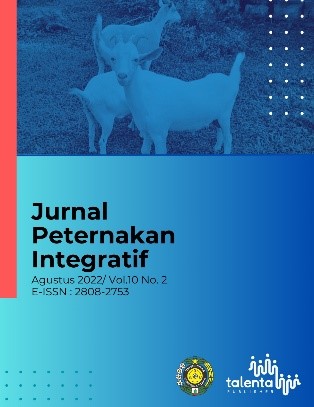Percentage of Local Sheep Carcases: Feed by Fermented Cassava Peel
DOI:
https://doi.org/10.32734/jpi.v10i2.8639Keywords:
cassava peel, empty body weight, fermentation, final weight, slaughter weightAbstract
This study aimed to determine the effect of giving various doses of fermented cassava peel by local microorganisms (MOL) on the percentage of carcasses of local male sheep. The research was carried out at Mr. Praditya Raharja's Ranch, Jalan Bunga Rinte, Simpang Selayang, Medan, from December 16, 2019 to March 8, 2020 using a completely randomized design (CRD) with 4 treatments and 5 replications. This study used 20 male local sheep with an average initial body weight of 12.59 ± 1.22 kg. The treatments were: P0 (without fermented cassava peel in the ration), P1 (25% fermented cassava peel in the ration), P2 (50% fermented cassava peel in the ration), and P3 (75% fermented cassava peel in the diet). ration). The parameters studied were final weight, slaughter weight, empty body weight, and carcass percentage.
The results showed that the application of cassava peel fermented by MOL in the ration had no significant effect (P>0.05) on the final weight (P0=26.17 kg/head, P1=23.34 kg/head, P2=24.50 kg/head, P3=23.43 kg/head), slaughter weight (P0=26.10 kg/head, P1=22.67 kg/head, P2=24.23 kg/head, P3=22.38 kg/head), body weight empty (P0=18.81 kg/head, P1=17.20 kg/head, P2=18.37 kg/head, P3=16.64 kg/head), carcass weight (P0=11.31 kg/head , P1=9.55 kg/head P2=10.15 kg/head, P3=9.27 kg/head), and carcass percentage (P0=60.17%, P1=55.16%, P2=55, 17%, P3=55,70%). The conclusion of this study was that giving fermented cassava peel to sheep still had a positive effect, as it did not reduce the body weight of the sheep's carcass and the percentage of carcass produced was more than 50%.
Downloads
Downloads
Published
Issue
Section
License
Copyright (c) 2022 Jurnal Peternakan Integratif

This work is licensed under a Creative Commons Attribution-ShareAlike 4.0 International License.
The Authors submitting a manuscript do so on the understanding that if accepted for publication, copyright of the article shall be assigned to Jurnal Peternakan Integratif as well as TALENTA Publisher Universitas Sumatera Utara as the publisher of the journal.
Copyright encompasses exclusive rights to reproduce and deliver the article in all forms and media. The reproduction of any part of this journal, its storage in databases and its transmission by any form or media, will be allowed only with written permission from Jurnal Peternakan Integratif.
The Copyright Transfer Form can be downloaded here.
The copyright form should be signed originally and sent to the Editorial Office in the form of original mail or scanned document.















